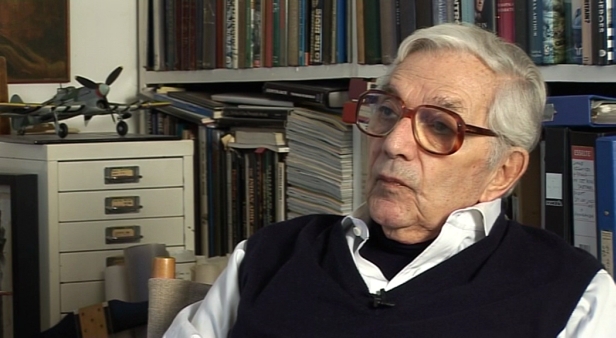NEXT STORY

The 'cab rank'
RELATED STORIES

NEXT STORY

The 'cab rank'
RELATED STORIES


|
Views | Duration | |
|---|---|---|---|
| 11. 'Little did we know how dangerous these bloody rockets were!' | 269 | 01:55 | |
| 12. Trying to avoid being hit by our own explosions | 227 | 02:00 | |
| 13. Finally getting commissioned | 193 | 01:33 | |
| 14. Defence mechanism against getting too emotional | 206 | 02:40 | |
| 15. 'I knew everybody was shooting at me' | 214 | 02:12 | |
| 16. Friendly fire | 192 | 04:43 | |
| 17. Losing fellow pilots on take off | 215 | 02:09 | |
| 18. The 'cab rank' | 184 | 03:10 | |
| 19. 'Order me a late tea' | 1 | 214 | 02:54 |
| 20. Norman Merrett | 1 | 175 | 03:44 |


We didn't have any proper airfields, you know – the engineers just rolled them. First of all it was a sort of wire mesh which was unrolled and then they got something which was called Summerfield Tracking, which a man, a gentleman – I suppose he was a German refugee, Mr Summerfield – had designed, which was these interlocking pieces of metal which are still used sometimes today.
And you remember, they had to build these airstrips in no time at all, but the problem was that we lost quite a number of pilots who on take-off used to have a flat tyre, get a flat tyre, and before they could pull the aircraft into the air they rolled on the flat tyre which then came off and the strut of the undercarriage dug in and the plane turned over, and we were sitting normally with our head in the blister to see where we were going, you know. And... but normally that accident meant that you broke your neck, and you'd had it. And after that happened, the Air Ministry said we have to try and take off blind, in other words, with our seat right down, so that if the aircraft turned over, you know, you were hanging by your straps but your neck wasn't broken.
So that was not very pleasant, you know, because one had to deal with a lot of these situations, and that was the first time also that we lost a lot of our friends that we'd share tents with and so on.
Sir Kenneth Adam (1921-2016), OBE, born Klaus Hugo Adam, was a production designer famous for his set designs for the James Bond films of the 1960s and 1970s. Initially, he trained as an architect in London, but in October 1943, he became one of only two German-born fighter pilots to fly with the RAF in wartime. He joined 609 Squadron where he flew the Hawker Typhoon fighter bomber. After the war, he entered the film industry, initially as a draughtsman on This Was a Woman. His portfolio of work includes Barry Lyndon and The Madness of King George; he won an Oscar for both films. Having a close relationship with Stanley Kubrick, he also designed the set for the iconic war room in Dr Strangelove. Sir Ken Adam was knighted by Queen Elizabeth II in 2003.
Title: Losing fellow pilots on take off
Listeners: Christopher Sykes
Christopher Sykes is an independent documentary producer who has made a number of films about science and scientists for BBC TV, Channel Four, and PBS.
Tags: World War II
Duration: 2 minutes, 9 seconds
Date story recorded: December 2010 and January 2011
Date story went live: 15 August 2011